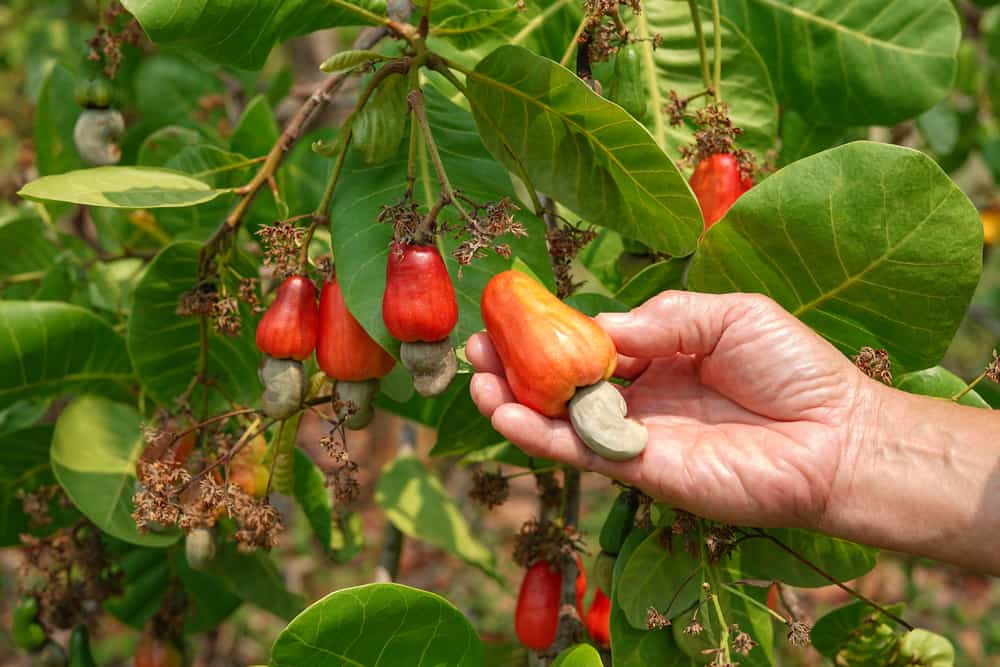
For most of us, we do not have to think about where our food has come from once it’s on the shelves of a grocery store. We may know that it comes from a tree, or an animal, or a processing plant but not much more. When it comes to cashews, most people would probably say that they’re picked from a plant of some sort and then packaged and delivered as a final product like raw cashew pieces. But the process of getting cashews to your table is long and can even be dangerous in some stages, especially when companies don’t follow ethical guidelines or operate under fair trade rules.
The first thing many people don’t realize about cashews is they are technically a seed, not a nut. This is because they form out of something called a cashew apple, which is a large swollen stem that looks similar to an apple you would think of today. Out of that stem grows a single cashew.
Cashew apples and cashew nuts typically form in the winter or a dry season. About two months after the fruit has set, the apple will take on a pink or red hue and the nut will turn gray, signaling they are ready to be picked. Many people will also wait for the apple to fall to the ground to ensure it is ripe. The nut can then be twisted to separate them from the apple.
The apples themselves are edible, though they are extremely perishable so usually must be eaten locally and immediately. However, the nut can be stored in a cool and dry place for up to two years.
Cashews are typically harvested from tropical locations, like Brazil or parts of Africa, and then sent overseas for processing. Asia, particularly Vietnam, has been a popular location in the past. However, Vietnam has historically used forced labor to process cashews. Beyond the Nut harvests and processes cashews in their home location of Benin, West Africa in order to empower local workers and cut down on the additional carbon footprint of shipping to a third locale.
There is an extra element that makes retrieving cashews from their apples tricky- the actual cashew is inside a shell, and that shell contains a toxic substance. This toxin, urushiol, typically causes a delayed skin reaction that is in the same family as poison ivy. Depending on the dose, type of contact, and your body’s reaction to allergens, this can be very mild or very severe. But it is not safe to eat and has to be removed entirely from the cashew.
Once harvested, cashews must be separated from this shell and cooked in order to remove this toxin entirely, making them safe to sell and eat. In fact, when you buy “raw” cashews, they have always been cooked in some way because of this process. While this can be done very safely, the unfortunate truth is that many cashew companies do not take the proper precautions and many laborers develop rashes and burns because of their handling of cashews’ toxic shells. Beyond the Nut adheres to fair trade standards that ensure workers have the proper training and safety equipment when preparing cashews.
This process typically involves the following steps: roasting, shelling, drying, peeling, grading, quality control testing, fumigation, and packaging. All of these steps can be done in a safe and cautious manner to ensure safe and good quality cashews.
Properly processed cashews are then ready to be sent to their point of distribution. It is important this is done in a way that protects the cashews, keeping them clean and fresh. If anything else is being done to the cashews, such as roasting for additional flavor (like honey) or changing the shape into raw cashew pieces or cashew halves, this would be done prior to packaging.
Packaging typically involves an airtight container and the use of non-toxic ink and glue to brand or mark the contents. You can then receive cashews that are safe to eat and well preserved.
Whether you choose raw cashew pieces, cashew powder, or cashews that have been roasted and covered in chocolate, Beyond the Nut guarantees good quality products that have been processed in a way that is safe for both the consumer and the worker.
Fuel Your Beyond with the Latest Discounts, Promotions, and Product Announcements
Free shipping on all U.S. orders over $25! Dismiss